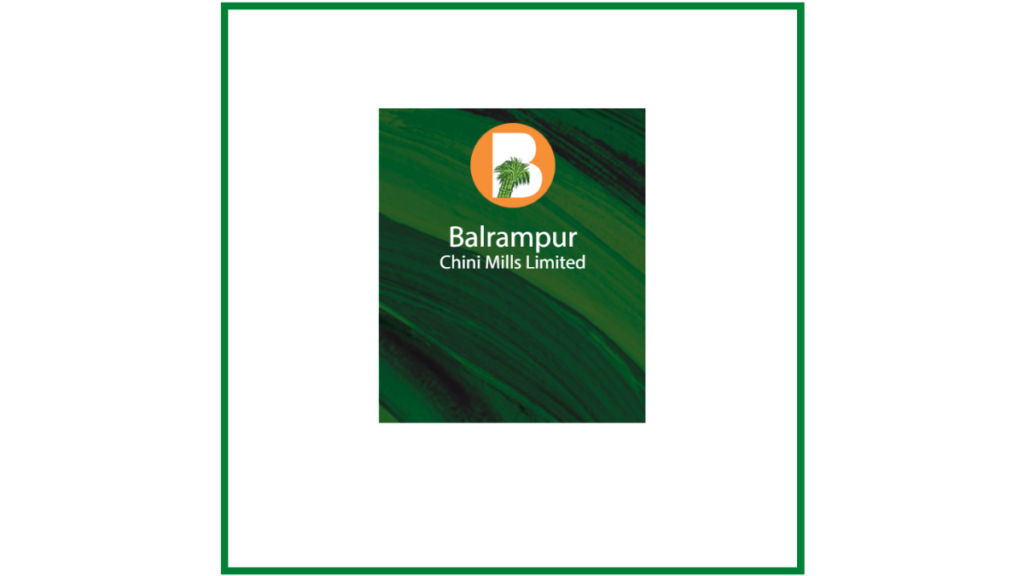
Balrampur Chini Mills Limited (‘BCML’) is the 2nd largest sugar manufacturing company in India with a significant strength in the manufacture of downstream products like power (co-generation) and ethanol.
BCML incorporated in 1975 as a wholly-owned subsidiary company of Balrampur Sugar Company Limited, subsequently changing its name to Balrampur Commercial Enterprises Limited (‘BCEL’). By an indenture of conveyance dated 21st February, 1976, BCEL transferred the land, building, other assets as well as the entire staff of its Balrampur sugar factory (with effect from 1st July, 1975) to BCML. BCML ceased to be a subsidiary of BCEL with effect from 25th June, 1979 and its shares listed on the Calcutta Stock Exchange (CSE) in 1979.
The Company possesses a cane crushing capacity of 76,500 tonnes per day, distillery capacity of 520 KL per day and saleable co-generation capacity of 163.70 megawatts.
Quick Links. Click to navigate directly to the paragraph in detail:
- Shareholding Pattern of Balrampur Chini Mills Ltd
- Executive Board Members
- Indian Sugar Industry Stats
- Revenue Segments & segments performance
- Sugar segment in detail
- Distillery segment in detail
- Last 10 years performance & financial highlights
- Management outlook & concall highlights
- Growth Opportunities
- Risks & Conerns
(A) Shareholding Pattern

Shareholding of Mutual funds and FPIs increased over the last 10 years. The Mutual fund shareholding increased from 3.5% to 12.6% over last 10 years. On the other hand the shareholding of Foreign Portfolio Investors increased from 12.90% to 21.57%. However the shareholding of Indian Promoters has remained almost same.

(B) Executive Board Members
Mr. Sumit Mazumder – Chairman & Independent Director
Mr. Sumit Mazumder is an MBA graduate. He was appointed as the President of CII (Confederation of Indian Industry) for 2015-16 and also is associated with many other companies. He is also the MD of Til Ltd. since 1995.
Mr. Vivek Saraogi – Managing Director
Vivek Saraogi is a former President of the Indian Sugar Mills Association. He was a committee member of FICCI and the Indian Chamber of Commerce in Kolkata. Shri Saraogi is a commerce graduate. Under his stewardship, the Company has grown rapidly through organic and inorganic means. This has helped Balrampur Chini Mills Limited emerge as a leader in the Indian sugar industry.
Total Remuneration of Mr. Vivek Saraogi for the year 2020 is Rs 607.63 Lacs which is 0.13% of sales and 1.17% of Net Profit.
(C) Products
1. Sugar


2. Ethanol
Supply of ethanol to oil marketing companies across the country for the ethanol blending program
3. Molasses
4. Alcohol
5. Bagasse
6. Power
(D) Indian Sugar Industry
(a) Employees over 5,00,000 farmers
The sugar industry in India is the largest agro-based industry after textiles. It employs over 5,00,000 farmers directly and acts as a livelihood for about 50 million sugarcane cultivators, supporting over 12% of the rural population directly or indirectly.
(b) Major consumer of sugar
Around 70% of the global production (in the last sugar season) came from the top ten producers. India, Brazil, Thailand, China, the US, Mexico, Russia, Pakistan, France, Australia. Consumption increased by an annual rate of 2.01% between 2001 to 2018, from 1.2 billion tonnes to 1.7 billion tonnes. This trend in consumption, however, has slowed to 0.8% in the latter half of the decade (2016-2018), primarily due to the debate on concerns relating to health.
(c) Industry with Cyclical Production
Its production is ‘cyclical’ which means that three years of the bumper crop followed by three years of crop failure. Sugar industry is also highly ‘politically sensitive’ because its demand is inelastic. Moreover, as with much of India’s politics, cane growers appear to be a reliable “vote bank”. Uttar Pradesh and Maharashtra, which together produce 70% of the country’s sugar, send 128 MPs to the parliament. Sugar is possibly the “most politicized crop in the world”. (As per BBC News)
(d) Sugar Production in India

India’s sugar production rose 13% till 15 June 2021, i.e. in 2020-21 marketing year at 306.65 lakh tonnes on higher sugarcane production, according to trade data.
Sugar marketing period runs from October to September.
“Sugar mills across the country produced 306.65 lakh tonnes of sugar between 1st October 2020 and 15th June 2021. This is 35.54 lac tonnes higher than 271.11 lac tonnes produced at the same time last year,” Indian Sugar Mills Association (ISMA) said in a public statement. Moreover, the country has the potential to export sugar to several countries.

UP and Maharashtra are the major sugar producing states in the country contributing around 70% of the total production. This is because the rainfall and weather conditions in these states are suitable for sugarcane crops. As a result most of the farmers are engaged in production of sugarcane in these states.
(e) Indian Sugar Consumption

Around 65% of sugar demand is made by B2B consumers that demand sugar in bulk quantity. Rest 35 % sugar is demanded by household sector. Moreover management expects that Sugar consumption in India is expected to grow. The Key demand drivers include GDP growth, rising disposable incomes, increasing demand for processed foods through modern retail, etc.

For SS 2020-21, India’s sugar production of 30.8 MMT is net of sugar sacrifice of ~2.0 MMT for production of Ethanol. As per market sources, ~5.7 MMT of sugar has already been contracted for export for the SS 2020-21. Further industry boosting factors include:
- Managed domestic demand/supply,
- Government initiatives,
- financial support to address surplus through exports,
- robust ethanol blending policies,
- moderating the sugar inventory and also supporting the domestic sugar prices.
(f) Other Major Players in Indian Sugar Industry
- Shree Renuka Sugars
- EID Parry Ltd.
- Dalmia Bharat Sugar
- Triveni Engineering & Industries Ltd
(E) Balrampur Chini Mills – Revenue Segments

(i) Segment Performance – Balrampur Chini Mills

- Distillery segment revenue contributed 14% of the total company revenue.
- Profit contribution of distillery segment is around 51% for FY21.
- The contribution from distillery segment increased because of more focus on ethanol from B-heavy molasses.
(F) Sugar segment overview – Balrampur Chini

(i) Price of Sugar commodity

In the last eight-to-nine months, the global sugar prices went up by almost 60% to 65%. Price of sugar touched the lowest point on 27/4/20 when it touched $0.09/LB and then it went up to $0.19/LB on 22/2/21.
The reason behind this:
- Brazil is one of the largest sugar producing countries in the world
- Brazilian production is going to be almost about 7-8 million tonne less than last year
- As well as the fact that the second-largest sugar exporter in the world, Thailand, for continuous two years, produced about 7-8 million tonne less than normal.
(a) Pricing Factors of Sugar
Price of sugar are market driven & depends on demand & supply of sugar. However, with a view to protect the interests of farmers, concept of Minimum Selling Price (MSP) of sugar has been introduced w.e.f. 07.06.2018 so that industry may get atleast the minimum cost of production of sugar, so as to enable them to clear cane price dues of farmers.
Minimum Selling Price (MSP) of sugar was first fixed at Rs. 29 per kg in June 2018 and later increased to Rs. 31 per kg in February 2019.
(ii) Fair Remunerative Price
- Fair and remunerative price (FRP) is the minimum price at which rate sugarcane is to be purchased by sugar mills from farmers.
- The FRP is based on the recommendation of the Commission of Agricultural Costs & Prices (CACP).
- This is to ensure a guaranteed price to cane growers. The ‘FRP’ of sugarcane is determined under Sugarcane (Control) Order.
The FRP of sugarcane payable by sugar factories for each sugar season:-

(G) Distillery Segment Overview – Balrampur Chini


*BL = Bulk Litre
(H) Financial Parameters – Balrampur Chini Mills

The profit of sugar companies mainly depends upon the raw material prices and the realization rate. As the raw material prices are fixed by the center and state Government. As a result various Government policies affects the performance of sugar companies.
(i) In FY 14
- BCM registered a reduction of 18.48% in gross revenue owing to decline in sugar sales in quantity and lower realizations. Surplus sugar stocks, following the withdrawal of the release mechanism, resulted in a decline in sugar realizations to Rs. 28 per kg before recovering to Rs. 32 per kg in March 2014.
- As a result, the sugar segment of the Company incurred a loss of Rs. 242.07 crores after providing for interest and corporate overheads.
(ii) In FY 15
- The company registered a growth of 12% in gross revenues. The growth was mainly due to higher sales volume of sugar. However their were Excessive production which led to a glut in domestic market. As a result sugar prices commenced to declining drastically from Rs.30 to Rs.25 a kg in U.P during the last 6 months of the financial year.
- Closing stock of sugar valued at year end was significantly lower than the production cost, leading to substantial loss in sugar segment. However Distillery & Power Divisions performed well and helped in reducing the losses.
(iii) In FY 18
- The Company reported a decline in its net profit due to lower sugar realizations and write down of inventory below its cost of production.
(iv) In FY 20
- Company reported higher revenue by 10% to Rs. 4741 cr on account of higher volumes and realization.
- Sugar recovery for the year stood at 11.44% as compared to 11.58% in previous year. During the sugar season 2019-20 the Company has diverted 327.01 lac quintals (38.3%) sugarcane for producing B-heavy molasses due to which sugar recovery lowered.
- The Company’s distillery segment performed well during the year. The Company produced 1275.75 lac BL of industrial alcohol during the year as compared to 1065.67 lac BL during the previous year, which was an increase of 19.7%.
- On the other hand the performance of the cogeneration segment was affected during the year. Total power generated during the year stood at 9024.18 lac units as compared to 10,497.13 lac units in previous year, a decrease of 14.0% as the Company decided to sell more bagasse outside than to use it to generate power in view of lowering of power tariff by UPERC (Uttar Pradesh Electricity Regulatory Commission). Average realisation for the year stood at Rs. 3.06 per unit as compared to Rs. 4.94 per unit in previous year.
(v) In FY 21
- The company saw lower sugar production in the current crushing season due to higher diversion of B-heavy molasses route. Also, adversely impacted by lower sugarcane yield due to red rot disease in the company’s catchment area. Low sugar demand in FY21 also affected the sugar realization.
- On the other hand the revenues from distillery segment was higher due to higher volumes of B-heavy ethanol. Which was the result of higher diversion of sugarcane for producing B-heavy molasses. The ethanol sales from B-heavy molasses in FY 20 was 2.5cr.BL(bulk litre) and in FY21 the sale of ethanol from B-heavy molasses was 9.56cr.BL. On the contrary the ethanol sales from C-heavy molasses was reduced from 8.37cr.BL in FY20 to 9.59cr.BL in FY 21. The company shifted its focus of B- heavy molasses because of higher realization as compared to C- heavy molasses.
- Further the realization in Cogeneration segment reduced because of reduced tarrif by UPERC (Uttar Pradesh Electricity Regulatory Commission).
(I) Management Discussion & Concall Highlights Q4 FY21
(i) CAPEX Plan
The Management has planned a CAPEX of Rs 425 crores. For the 320 KLD distillery expansion plant at Maizapur. The plant is expected to be commissioned by December 2022. This distillery will operate on duel feed i.e. sugarcane juice during the season while on grains during off-season leading to utilization of the same throughout the fiscal aiding the profitability.
(ii) Payment of Debt
The company would repay the long term debt as per schedule while working capital debt requirement would reduce significantly. However, BCML’s current debt is below 4% interest rate.
(iii) Introduction of new sugarcane variety
Red rot disease of sugarcane affected the sales of the company in FY 21 as the company is over dependent upon the single variety of sugarcane. As a result the company is trying to make an effort to introduce new sugarcane varieties, which would help in mitigating any red rot issues in future. Probably, the company could be first to introduce this new variety.
(iv) Higher Sugar Exports
Management Expects that the current sugar season is expected to witness highest ever sugar exports to the tune of 6.8 million tonnes (MT). Further The industry would be keen to export under OGL(Open General License) (without subsidy) at 19-20 cents /lb.
(v) High realization by B- heavy ethanol
BCML is diverting more cane towards producing B-heavy molasses which will lead to higher Ethanol production. As the profit margin is high in ethanol producing from B-heavy molasses as compared to C-heavy molasses. The ethanol production from B- heavy route molasses witnessed growth of 26.5% in FY 21 which was 10.18Cr. BL(Bulk Litre) as compared to 3.58 Cr. BL (Bulk Litre) in FY20.
(vi) Management Outlook
- The Indian Sugar industry has urged Government to hike the MSP(Minimum Support Price) on sugar in order to help millers clear the farmer dues. However that request is still pending for final approval.
- Moreover the Government has reduced financial assistance on Exports of sugar. However Management thinks that this policy will not affect the company as the company has already contracted the allotted quota before the applicability of the policy.
- Balrampur Chini Mills Ltd is on course to meet its target of 10% blending country wide by 2022 against the current year blending which is expected to be 8.5%.
(J) Growth Opportunities for Balrampur Chini Mills
(i) Established market position
The company has the capacity to crush 76,500 tonne per day (TPD) of sugarcane, and exportable (surplus) power capacity of 165.2 MW and distillery of 520 kilo litre per day (KLPD). BCML is the second largest player in terms of scale on a pan-India basis. It has ten sugar factories eight in eastern UP and two in central UP and being present in UP, has access to a larger North India market.
(ii) Superior and improving operating efficiencies
BCML’s superior operating efficiencies emanate from its fully integrated nature of operations, increasing contribution to profitability from higher margin distillery segment, better sugar recovery rates and higher capacity utilisation leading to better absorption of fixed costs. The company’s distillery as well as co-generation capacity is adequate to utilise all the molasses and bagasse produced through the crushing operations thereby resulting in fully integrated facilities.
(iii) Mandatory ethanol blending program of the government driving ethanol offtake
The new government policy of ethanol blending is key opportunity for the company. In addition for this the company has planned the capex which will be profitable in future.
(iv) Comfortable financial risk profile
Low long term debt, strong debt protection metrics and healthy liquidity are the basic measures to check the company’s financial risk profile. Absence of any significant debt funded capex since fiscal 2008 and continuous debt repayment has resulted in a decline in the term debt levels of the company which is estimated at below Rs 400 crore in March 2021.
(K) Risks/Concerns for Balrampur Chini Mills
(i) Susceptibility of business performance to downturn in the sugar business
Prices of sugar depends upon the production. Hence, higher production which adds to the sugar inventory levels may lead to steep fall in prices and impact profitability severely given that the cost of production is relatively sticky in nature. Dependence on monsoons have also rendered the sugar industry cyclical as monsoons have a bearing on cane production and recovery rate of cane impacting the sugar production in the country.
(ii) Exposure to regulatory changes in the sugar industry
Various government regulation like fixing MSP of sugarcane affects the prices of sugar. Thus the profits of the company remain vulnerable.
(iii) Dependency upon climate condition
Production of sugarcane highly depends upon the climate condition. Therefore unfavorable climate conditions could harm the production of the finished product as well.


Drop us your query at – info@pawealth.in or Visit pawealth.in
References: Annual Reports, News Publications, Investor Presentations, Corporate Announcements, Management Discussions, Analyst Meets & Management Interviews, Industry’s Publications.
Disclaimer: The report only represents personal opinions and views of the author. No part of the report should be considered as recommendation for buying/selling any stock. Thus, the report & references mentioned are only for the information of the readers about the industry stated.





